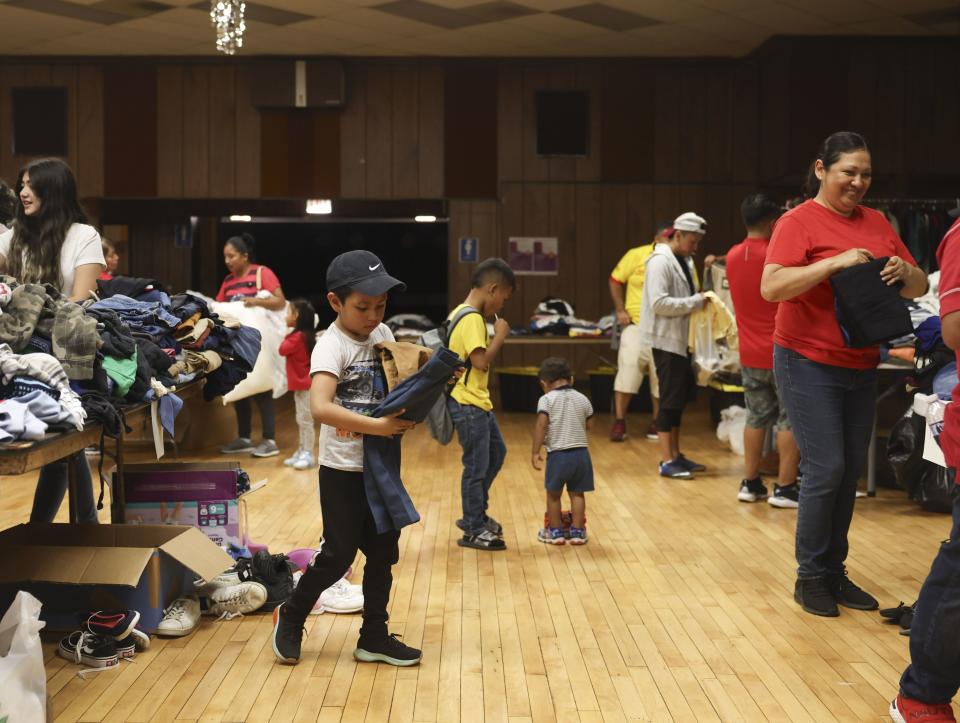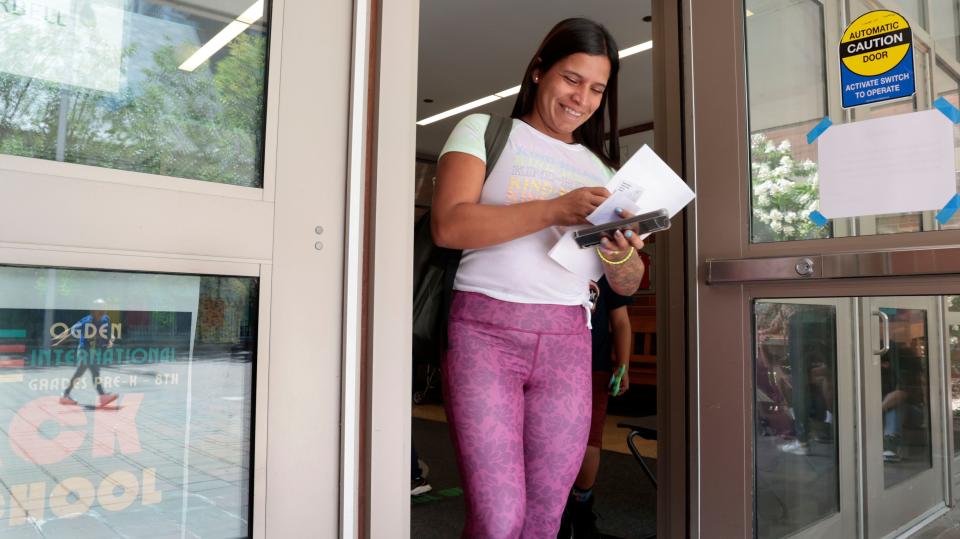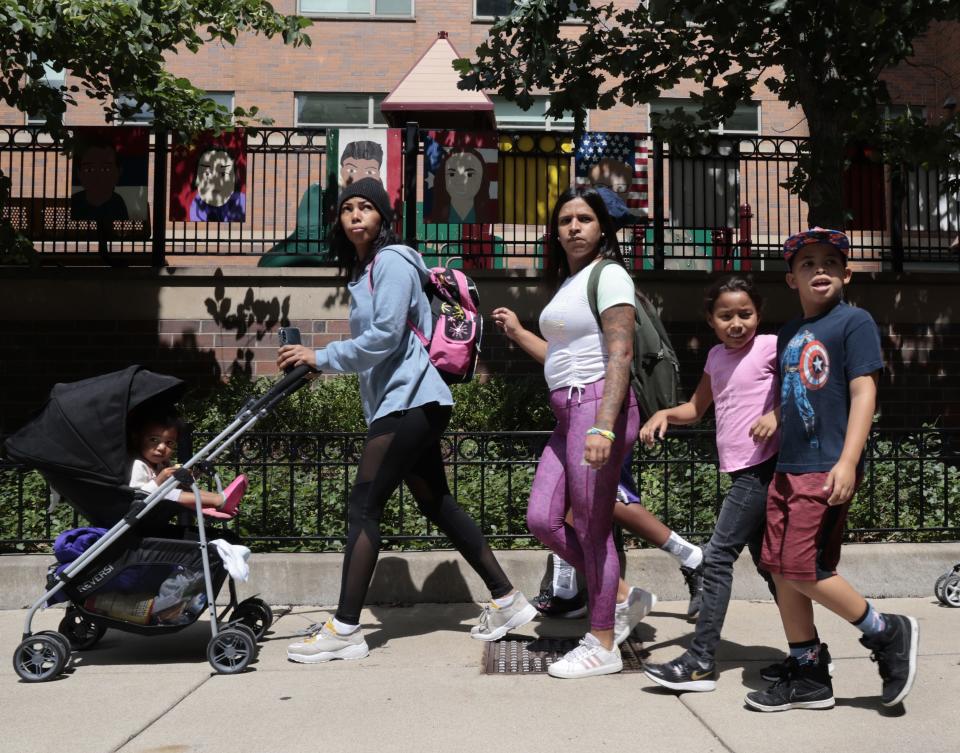Children of the crisis: CPS prepares to welcome migrants who will need much more than schooling to heal from trauma
They waited for more than five hours. Just days before her son, Ronald, started third grade in Chicago Public Schools, Maria Alejandra Larez was on a quest to get him gym shoes and a pair of jeans for his first day of school Monday.
They lined up next to nearly 100 asylum-seekers outside a church in the Belmont Cragin neighborhood to enter a back-to-school donation center that parishioners had set up for migrants. The 9-year-old got a backpack and some school supplies, but he couldn’t find shoes.
The two arrived in Chicago from Venezuela, seeking asylum, earlier this month after a monthslong journey, and even though he is nervous, starting school “finally gives us some peace,” Larez said in Spanish.
After all the turmoil they have experienced, she hopes teachers can provide a safe space for Ronald, not only to learn a new language, but to cope with the traumas they have experienced, leaving behind everything they knew and facing an uncertain future in a temporary shelter.
“Mi hijo está nervioso, pero ansioso de comenzar clase,” Larez said. Her son is nervous to start school, but eager to begin.
As Chicago Public Schools begins the 2023-24 school year Monday, the district has been preparing to accommodate new English learner students — the category for most migrant children — with about 1,000 of them enrolling through the summer. And officials said they anticipate about 1,000 more will enroll this year from the families who are living in temporary shelters and police stations, where asylum-seekers stay as they await housing.
CPS said it increased funding for bilingual instruction by $15 million in its 2023-24 budget, including $8 million in additional funding for enrollment adjustments at schools that received new English learners after school began in 2022. The money is for additional staff members at those schools, and the district will be monitoring enrollment trends this year and allocating resources accordingly, a spokesperson said.
Last year, about 290 schools established bilingual advisory councils, and CPS had nearly 3,000 teachers with a bilingual endorsement, an increase of 900 iover the prior five years.
CPS also increased funding to support students’ social and emotional health by $35 million in its current budget. The district said it added 123 school counselors, primarily in elementary schools, over the last two years, and also said each school has a behavioral health team, which may include a nurse, psychologist, counselor or social worker.
Despite additional resources for newcomers, many argue there should be a greater emphasis on addressing the children’s mental health as migrant children have faced unique traumas through their journey but also while living in temporary shelters.
Though attending school is a gateway for migrant families and their children to access therapists and counseling, experts worry that teachers may not be equipped to respond to the children’s needs, and they call for a trauma-informed approach to services.
The sudden addition of asylum-seekers who enrolled at Haugan Elementary in Albany Park over the past year required a lot of pivoting and collaboration from teachers, staff members, community partners and parents, said Principal Heather Yutzy.
Nearly 100 children, mostly from Ecuador and Venezuela, enrolled in the school from November to June. Over the summer, Yutzy said, about 50 more migrants, some living in nearby police stations and a church, have also joined the school.
Beyond mobilizing to accommodate the children’s academic needs, the school community also held clothing and food drives for the families. For Yutzy, it was evident that parents were also desperately seeking mental and medical help for their children, she said.
“The mothers are saying, ‘My child is traumatized. I need help,’” Yutzy said. Many of the younger children have separation anxiety and cry at school because they’re worried they won’t ever see their parents again, she said.
Leaders at Haugan organized sessions for parents with school counselors and social workers so parents could discuss their child’s psychological health and get referrals to community agencies and partners, including a team of Spanish-speaking psychologists from the University of Illinois Chicago who have been a key part of the school’s response.
“But there’s a limit to what you can do at a school to offer that trauma therapy,” Yutzy said.
Still, teachers at Haugan have come up with strategic ways to help the children cope. Some helped the younger students make family books with pictures of their parents and reassured them that Mom would return to pick them up at the end of the day.
“I held kids in my lap while they cried,” Yutzy said.
The children who made the dangerous and tumultuous journeys from Central American countries to the United States with their parents “are the most innocent victims,” said Elisa Lopez, an emergency responder for mental health at Rincon Family Services Welcoming Center.
For Larez and Ronald, it’s their faith that has allowed them to cope with the desperation of being stuck in a hotel room with three other migrant families as they all wait to find housing and employment.
“I tell him to be patient, that this won’t be our forever,” Larez said. “I tell him to pray, to have faith.”
Throughout their journey, she said, they saw “terrible things, unimaginable” — people dying, robberies, abuse and sexual assault. They experienced cold and hunger, having to sleep in the streets, she said. “It’s a lot for a child,” she said.
Ronald sometimes can’t sleep at night, his mother said. There are days where he goes to sleep hungry because the food at the shelter is not enough. Then he starts feeling anxious, wanting to play outside, “like a normal kid,” she said. But he can’t because there’s no safe space for him to play.
In Venezuela, he was a good student, she recalled. His favorite subject was reading. Despite the fear of judgment, the boy has also learned to be resilient, she said. “He can’t wait to go to school to learn English,” Larez said.
During a recent visit to a city-run shelter, Aimee Hilado, a professor, clinician and an expert on immigrant trauma at the University of Chicago’s Crown Family School of Social Work, said she noticed the high level of stress and anxiety in which children live, but which many won’t express.
“They internalize the trauma that could get in the way of building peer relationships and preventing school readiness,” Hilado said.
Hilado has led multiple trauma-informed training sessions, funded by the Illinois Department of Human Services, with shelter and hotel staff members, mutual aid volunteers and other community-based organizations working directly with migrants.
Hilado has encouraged eliminating the stigma and criminalization behind their status as immigrants in the country without legal permission — and creating safe spaces. Most shelters, she said, don’t have a playroom or space where children can safely congregate.
“We have thousands of kids that are entering public schools, and we just need a sensitivity that there is an emotional wellness need that is there that needs to be addressed before we even think about academics,” Hilado said.
Many of the children that will begin classes Monday are living in temporary spaces, and “it doesn’t feel like home,” Hilado said.
Asylum-seeker children face a set of traumas that put them at high risk of developing post-traumatic stress disorder, according to Amy Hill, manager of Heartland Alliance’s Kovler Child Trauma Program, which is dedicated to providing mental health treatment and services to immigrant and refugee youths who have experienced trauma in their home country, during the migration journey or as part of the resettlement process.
Hill said that it is imperative that all teachers, or those who are working with migrant children, seek trauma-informed training to ensure they are responding appropriately and not triggering the children.
“But the school needs to have an understanding of the way in which trauma might be showing up for these children, how that may be impacting their ability to feel safe in the school, their ability to make friends or their ability to focus on their academic success,” Hill said.
Potential long-term effects of the trauma include feeling unsafe and unable to trust, depression, anxiety and physical health issues.
“Children ... don’t understand political issues, economic problems, kidnapping or other violent crimes in their countries,” Lopez said.
“My biggest worry is that I’m unsure if staff at the schools these kids will be attending are ready to assist these children psychologically and from an empathetic perspective,” she said.
Yutzy plans to hire a retired therapist from Colombia to help the new students at her school, she said.
At Carl Von Linné Elementary in Avondale, an estimated 60 children living in a nearby temporary shelter are enrolled, but Principal Gabriel Parra is expecting an increase for the coming school year.
Though he has only one counselor and one social worker for the entire school, last year he used additional funding to provide professional development for his existing teachers. Many added a lesson about the journey of asylum-seekers as part of their curriculum to build understanding of the humanitarian crisis and empathy among the student body toward their new classmates.
“I had the opportunity to talk to the families about the details of their trajectory here,” Parra-Carl said. “The stories have been horrible, but what I’ve noticed is that outside of the trauma that is very real, is that the kids are thirsty for normalcy.”
Parra-Carl, a native of Venezuela, arrived in Chicago with his family when he was a child. He understands, he said, why these families are fleeing the authoritarian regime in that country.
Even if schools don’t necessarily address the mental health needs of the children, attending schools is the most effective way for children to get a sense of normalcy and stability back into their lives, said Hilado, who has been working with refugees and asylum-seeker children for a decade.
“Routine and a sense of normalcy is critical for the migrant children to cope with the trauma and school provides that,” she said. “Even if they’re still navigating new language, there’s something about being with children their age that could be critically helpful, healing and soothing after so much chaos.”
At Haugan, trying to meet both the academic and the emotional needs of their new students has been and will likely continue to be a challenge, Yutzy said. But she praised her teachers and staff for their work to ensure that the migrant children and their families feel welcomed.
Since the students began to arrive in November, she has added three bilingual classrooms and a resource teacher. Thanks to a budget bump, she also hired five retired bilingual teachers who worked part time to tutor and help children recover academically. Most migrant children have missed months, if not years, of schooling, she said.
“Those retired bilingual teachers have been miraculous for us,” she said.
Karime Asaf, the chief of language and cultural education, said CPS is partnering with the Chicago Teachers Union to find volunteers to ensure that migrant children across the city get help enrolling in the school nearest to them. She said the district is working to equip all schools with the resources necessary for intake, but there is a focus on trying to place students in schools that have a bilingual system, programs and curriculum already in place.
At the city’s welcome center, which opened in July at Roberto Clemente Community Academy in West Town, CPS staffers have been assessing each child’s language, academic and social emotional needs, in addition to enrolling them in school and connecting each family to medical care and social services, CPS CEO Pedro Martinez said at a Chicago Board of Education meeting in July.
Services at the welcome center are limited to families in West Town or Humboldt Park or those who’ve received a referral from a city agency or community organization, Martinez said. But “any CPS student at any school” can receive the same services, he said.
“Our hope is that by centralizing the supports within the welcome center model, we can improve the efficiency and learn how to better serve our new arrival families around the city,” Martinez said. “If it proves successful, and there’s an ongoing need, we will consider expanding the model to other parts of the city.”
However, according to Chicago Teachers Union member Rebecca Amaya, who has volunteered with families staying at the 9th District police station, trips to Clemente pose a challenge to migrant families who face multifold issues.
“Parents and children I have been in contact with have expressed the need for widespread mental health services, bilingual services, orientation and guidance for parents. Mobile units that meet families where they’re at will be necessary to meeting their needs moving forward,” Amaya told the Board of Education in July.
There are other barriers to providing migrant students a quality education. “We don’t have enough capacity to provide ESL or native language instruction, including in languages other than Spanish,” Walt Disney Magnet School teacher Kathryn Zamarron said at the meeting.
More than 180 home languages are spoken by CPS families, a spokesperson said, and 22% of all students are English learners.
In partnership with the Center for Childhood Resilience at Ann & Robert H. Lurie Children’s Hospital of Chicago and Loyola University Chicago, two staff members each from 20 CPS schools last year participated in intervention training that focuses on meeting the needs of immigrant and refugee youths. CPS said 30 schools this year will be eligible to opt in for the training.
Meanwhile, Ronald Larez will begin third grade at Ogden International School in West Town, hopefully having found a pair of shoes that fit.



